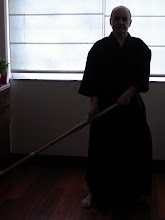Yaki-Ire - How a Tanto Blade is Born from Crossed Heart Forge on Vimeo.
Process of Clay Tempering a Tanto Blade (crew: me and a camera on a tripod)
Once the steel is shaped as much as possible in its softer state, it is coated with a thin layer of clay along the edge and a thicker layer on the body and spine. During the hardening process, the split second difference in cooling time caused by the clay layer creates two different hardness areas in the same piece of steel. The edge cools faster and forms a very hard steel structure called martensite while the body cools slower and forms a very tough steel structure made of ferrite and pearlite. The boundary between these two areas is called hamon and is commonly seen as a frosted wavy line down the length of a polished sword blade.
When the clay is fully dry, a charcoal fire is used to heat the steel slowly and evenly, taking care not to overheat any part of it. First the spine is heated to bring the whole blade to just below temperature, and then it is flipped over to focus heat on the edge. When the entire edge is at the correct temperature, it is plunged into a hot water bath, edge down, and held until cool (yaki-ire). The hardness is checked with a file and the process repeated if necessary. After hardening, the clay is removed and the steel is heated slightly again to remove some of the internal stresses (yaki-modoshi). Once this process is finished, and if the steel survives, the blade is ready for Togi, hand polishing.





No hay comentarios:
Publicar un comentario